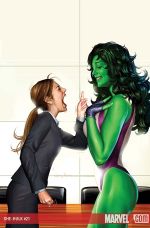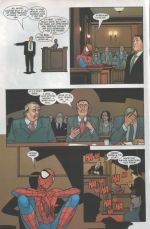When Dan Slott’s first issue of She-Hulk came out in March 2004, hopes for its future were not exactly high. The character had had two previous runs in solo titles, both of which had been cancelled after short (but still respectable length) runs, and was a female “version” of a male character. The writer was best known for working on cartoon tie-in titles like Ren & Stimpy and Batman Adventures.

The artist had a style that could best be described as “unconventional”. It launched the same month as Captain America & The Falcon, Iron Fist, Alpha Flight and Cable & Deadpool. It generally wasn’t expected to be around for very long. Now, after 33 issues (and an 8 month hiatus which came after issue 12), Dan Slott is leaving the title to concentrate on Avengers: The Initiative and Amazing Spider-Man. Taking over from him is former Incredible Hulk writer Peter David.
Slott’s first issue introduced both the mousy lawyer Jen Walters and the superhero and wild party animal She-Hulk, and the characters of Holden Holliway and Mallory Book of the superhuman law firm Goodman, Lieber, Kurtzberg and Holliway. Issue two brings in the rest of the supporting cast – lawyer Augustus “Pug” Pugliese, shape-changing process server Ditto, archivist Stu Cicero and office gopher Awesome Andy, formerly known as the Mad Thinker’s Awesome Android. By the end of the issue, the stage is set for the tone of the series – superhuman law cases at the heart of the Marvel Universe. So we get a man suing the company for the industrial accident that caused his origin, a ghost testifying at his own murder trial, and in one of the best single issues of any title of the last few years, Spider-Man suing the Daily Bugle for libel. The fun continued through until issue 12. Although popular with critics and with a very vocal fanbase, the title wasn’t selling. Marvel still had faith in the title and placed it on hiatus for eight months, and then relaunched with a “second season”.

The second season started in a similar vein to the how the first had ended, with more superhuman law and continuity-based fun. Until the Starfox storyline. Former Avengers team-member Starfox was accused of using his mind-altering euphoria powers to sexually assault many women. Obviously, this was a darker and more serious storyline than a lot of those that had come before, and while there were still some fun touches, this storyline divided the fanbase somewhat. It also went on for quite some time, in a title that had previously been known for one and two-parters – although in some of those issues the storyline was used more as a sub-plot, while dealing instead with some of the effects of Starfox’s power - Jen marrying John Jameson, and Mallory Book’s romantic relationship with Awesome Andy.
Yes.
Next came the four-part “Planet without a Hulk” storyline – newly drafted as a S.H.I.E.L.D. agent, Jen helps to track down former Hulk foes. This leads to a revelation about the Illuminati’s treatment of the Hulk (in the Planet Hulk storyline which was just finishing over in the Hulk’s own title), and a confrontation between Jen and (S.H.I.E.L.D. head/Illuminati member/Iron Man) Tony Stark, leading into Marvel’s current World War Hulk crossover storyline and Jen’s depowering.
It was at this point that Dan Slott made the choice to leave the title and concentrate on his forthcoming role as one of the writers on the revamped Amazing Spider-Man, and the final issues of this title wrap up a few of the things he wanted to deal with. So in the space of three issues we have the trial of The Leader, several short vignettes detailing little adventures that might have lasted a bit longer if Slott wasn’t about to leave… and then came the final issue.
Using a plot point from a seventies issue of the Fantastic Four, Slott reveals that over the years, people have been travelling over from a parallel Earth (Earth-A) to Marvel Earth as tourists. The transporter involved resequences your atomic structure to match that of your Marvel Earth counterpart, so that if they have superpowers, so do you. This leads to people coming over from Earth-A and pretending to be their Marvel Earth counterparts and making little mistakes in the process - leading to cases of mistaken identity, heroes and villains appearing to be in two places at once, people recovering from injuries or coming back from the dead, changing costume, and just generally acting “out of character”. In other words, causing about 90% of all continuity errors.

Slott has lots of fun with this, using it to quickly explain all kinds of continuity fudges (including settling once and for all the reason why She-Hulk has always disputed sleeping with The Juggernaut - she didn’t, it was her Earth-A counterpart), and blaming the mistakes made by the travellers on those who “couldn’t be bothered to take five minutes to read their darned handbook”. Eventually the main dimensional hole is closed forever (and Jen gets her powers back in a rather neat way), but it appears that there’s no way of stopping travel entirely, and so there will probably always be “A-holes” causing problems.
Slott’s run definitely won’t be for everyone. Although most of the references to other titles and wider Marvel history are usually explained well enough to follow the story, it sometimes takes awareness of the stories being referenced to realise that it’s all there. There are a multitude of artists over the run, with very different approaches - the first “season” featured the very traditional American comic book art style of Paul Pelletier and the more humorous European graphic album style of Juan Bobillo. The comedic element is comparable to Slott’s other Marvel works, or the better issues of Giffen/DeMatteis’ eighties Justice League run - while there are a lot of fun moments, they don’t come at the expense of the story or stop from taking the characters seriously.
At the start of his run, Slott was just beginning to become a name writer for his Batman miniseries Arkham Asylum: Living Hell, and his work on the DC animated books (despite having worked in comics since the early nineties). Since then, he has written a Spider-Man/Human Torch miniseries, a short run on a Thing solo title (that should have lasted far longer, but unfortunately not enough people felt the same way), and most recently the Free Comic Book Day Spider-Man title, and Avengers: The Initiative. It’s arguable that he might not have got any of these jobs without his She-Hulk run to pave the way.
-
 Russell Hillman was born in London but now lives in Coventry. His hobbies include precious little. He doesn’t get out much, but thinks reading a lot of comics makes up for it. He’s wrong.
Russell Hillman was born in London but now lives in Coventry. His hobbies include precious little. He doesn’t get out much, but thinks reading a lot of comics makes up for it. He’s wrong.
